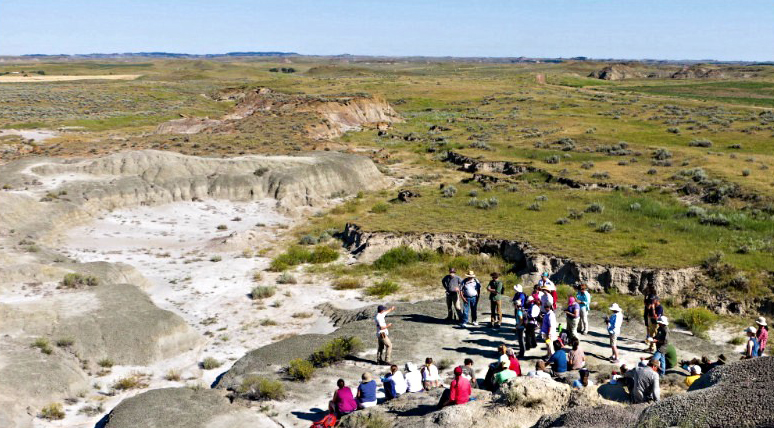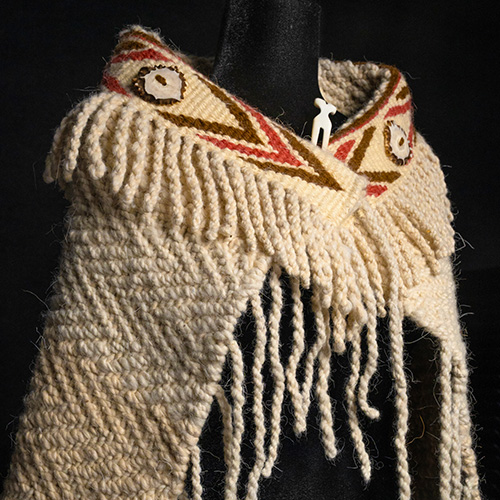“What did you do over your summer vacation?”

Every September, grade school students answer that question with a litany of activities, from sports camps to Disneyland to visiting grandparents. But this year, fifth grade teacher Pam Muncey has them all beat. In late July, at a remote site in Montana, she helped excavate a Tyrannosaurus rex fossil.
“I touched dinosaur bones that were 66 million years old!” exclaims Muncey (BA, English, 1981; TEPFO,1985), a teacher at South Whidbey Elementary in Langley, Washington. “How do you even imagine something that magical and mind-blowing? It still makes me shiver.”
Muncey was among the 35 K-12 teachers from across the country enrolled in the Burke Museum’s DIG (Discoveries in Geosciences) Field School, a professional development program that introduces teachers to the basics of paleontology and immerses them in scientific methods. The year-round program includes a four-day field experience in northeastern Montana, where the teachers get their hands dirty — literally — working alongside researchers at an excavation site in Hell Creek State Park. The site is famous for its wealth of fossils from the Cretaceous period, when triceratops and T. rex roamed.
UW professor Greg Wilson began working at the site years ago as a graduate student, and it remains his favorite research setting. He founded the DIG Field School there in 2009 with then graduate student Lauren Berg DeBey (PhD, Biology, 2015). “The idea from the beginning was to give teachers an authentic experience by involving them in whatever we were working on,” says Wilson, associate professor of biology and adjunct curator of vertebrate paleontology at the Burke Museum. “One of the most important things we can give them is a perspective on the process of science and what we actually do, rather than some manufactured experiences that we’d never actually have as scientists.”

The program started small but grew quickly after Burke Museum board member John Pohl became involved. Pohl, a paleontology enthusiast, had an interest in science education for teachers and was excited by DIG Field School’s immersive approach. He encouraged Wilson and DeBey to expand the program, providing financial support and helping secure other funding, including sponsorship from Chevron Corporation. Pohl also attended the field school in 2011 with his daughter, a sixth grade science teacher.
I touched dinosaur bones that were 66 million years old! How do you even imagine something that magical and mind-blowing? It still makes me shiver.
“I was like a kid in a candy store,” Pohl says. “Within minutes of being in the field I picked up a bone fragment — the remains of a frill from a triceratops! But I did not get to simply ask, ‘What is this?’ I had to think through what it looked like, where I was, what layer of earth I had found it in. And I could see the teachers around me rapidly grasping the research methods. It was easy to see how this would translate back to the classroom and how they would become better teachers as a result.”
While some teachers who attend the program are fossil hounds like Pohl, many arrive in Montana with no field experience. On the first day, the staff orients the teachers to the area’s geology, the Cretaceous period, methods for geological observation, and the tools they’ll be using. The next day the teachers assist researchers at an active excavation site. On day three they work on independent research projects in groups, presenting their findings to their peers and the staff that evening. The final day is spent discussing how to bring some of the lessons and excitement of the field back to their classrooms.

“I went into this project knowing very little about paleontology and feeling uncomfortable outside my comfort zone,” says Sarah Coulson, a fifth grade teacher from Lacey, Washington. “This reminded me of how my students feel every time I ask them to try something new. The instructors were amazing, patient, and took time to make sure that we were all ready for the next step. It was a little intimidating presenting information to the experts, but by the time we got to the end of the week, we were ready.” The instructors include knowledgeable UW faculty, graduate students, undergrads, and alumni, most of whom volunteer their time.

The teachers experience both the highs and lows of a paleontology career in four days. The work is physical, in the middle of nowhere, in oppressive heat, often with nothing to show for the effort. “Two hours of not finding anything feels like a really long time in those conditions,” says Wilson. “Since the teachers had some of those lower moments, it was really fun to also give them the highest high.”
Wilson is of course referring to the T. rex excavation on the second day. Before the teachers arrived, the crew had been working at the site for about three weeks and had unearthed the back of a T. rex skull and several ribs. The teachers excavated with the crew in search of more bones, and detailed the layers of earth to better understand when the T. rex died and how it was buried.
“It’s really hard not to get a little bit geeked about T. rex,” says Wilson. “To see the scale of it, it’s just over-the-top impressive. I think the teachers were all completely beside themselves, and they sensed that the instructors were just as excited. They sensed that they were part of something really cool.”

The day after the teachers’ visit, the crew uncovered the rest of the T. rex skull and realized they had a beautifully preserved specimen. The discovery became international news. Wilson told the teachers and instructors about the skull around the campfire that night. “They erupted,” says Wilson, “and the rest of the evening and next day was filled with a buzz of excitement and being part of something remarkable.”
The best part is that the teachers now get to share that experience with their students, year after year, making science relatable through their personal stories and photos. Burke DIG boxes and curriculum materials provide additional content, including the opportunity for K-12 students to examine actual sediment from the Montana site in search of smaller fossils.
“We send a fresh bag of Montana real estate to the classroom so that teachers can share that experience of discovery with their students,” says Wilson. “The students examine the sediment using a microscope or some other form of magnification, and if they find any small fossils, they can identify them using a guidebook we provide. It gives them a sense of participating in the research, it connects them with the Burke, and they get the sense of discovery.”
Still, nothing quite compares to unearthing an intact T. rex. After returning from Montana, Muncey was so excited by the discovery that she sent news links about it to everyone she knew.
“I have been stopped in the grocery story many times and asked, ’Were you really there?’” says Muncey. “I think I am kind of famous right now.”
. . .
For more about DIG Field School, visit digfieldschool.org. A press release from the Burke Museum provides more information about the T.rex discovery. The skull, encased in plaster, is on display at the museum through October 2.
More Stories

A Healing Heart Returns
In February, the UW Symphony will perform a symphony that Coast Salish elder Vi Hilbert commissioned years ago to heal the world after the heartbreak of 9/11. The symphony was first performed by the Seattle Symphony in 2006.

The Public Impact of Private Cities
Geography major Edwin Bai has researched private cities, developed by individuals and corporations, that "take the libertarian idea of low government regulation to the maximum."

Coast Salish Traditions are "Woven in Wool" at the Burke
A Burke Museum exhibit, co-curated by Coast Salish weavers and Burke curators, highlights the importance of weaving to Coast Salish communities.